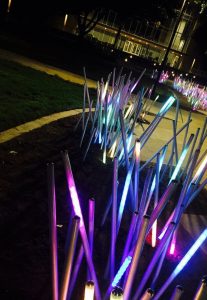Over the summer ACU sought out a way to combine creativity and technology to construct an interactive sculpture for the newly innovated quad. We asked Dr. Brent Reeves, one of the collaborators on the project,a few questions about this creative partnership.

What made you want to be involved with building this sculpture?
Nil Santana teaches Art and serves as director of the ACU Maker Lab. He invited several faculty to work on the project that was to “combine science, technology, and art.” Hardware, software, possible blinking lights – that sounded great!
Explain what your role was for setting up and planning for the sculpture.
I worked with Nil to research outdoor installations and build prototypes of light-ish things, for example different configurations of RGB LED strips. We met with the donors, proposed potential hardware-and-software things. We had weekly meetings with Viget about hardware and software issues.

In very simple terms, explain what you did in creating the app to control lights?
We realized we wouldn’t have time to build the hardware and write the software here at ACU, so we wrote a request-for-proposal and received a bid from a consulting firm named Viget. The system they made consists of a server in the cloud and 35 computers buried in the ground. Each computer has WiFi and is responsible for driving the LEDs on 10 reeds. Overall, there are 350 reeds and about 20,000 LEDs.
One nice thing about the app is that it isn’t an app. You don’t have to install anything on your phone. Instead, you use a browser to visit lightwalk.acu.edu to choose an effect. The server in the cloud sends a message to one of the computers in the ground telling it which effect to run. In turn, it tells its 34 neighbors what to do next.
What sort of team did you assemble to get the job done?
The ACU team consisted of students, faculty, and staff. For example, Scot Colley had to hire electricians to install a new transformer in the quad. The Viget team include hardware and software engineers.
Is there anything else that you would want to tell us about this project?
Cole Spears is the first ACU student to design an effect (called “Shimmer”) that is now running live on the system. Next Thursday, Oct 19, after SITC “3:16” chapel, we will have a brief tutorial session on how to make effects. So any student interested in making cool effects should join us.
To learn more about the making of Lightwalk, click here.
